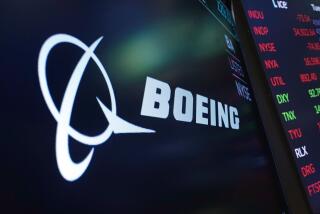Judge in $1.2-Billion Case Sees How Satellites Are Built : Hughes Aircraft Patent Suit Shifts to Plant
U.S. Claims Court Judge James T. Turner traded his black judicial robe for a white one Friday as he convened an extraordinary court session inside the El Segundo satellite production facilities of Hughes Aircraft, which is suing the government for patent infringement.
Donned in a technician’s white smock, Turner was given a nearly three-hour show-and-tell session by Hughes Aircraft Chairman Albert Wheelon, who explained in detail how communications satellites are built.
Hughes is suing the federal government for $1.2 billion for infringing on a key patent that Hughes believes enabled the creation in 1963 of practical communications satellites and their growth into a multibillion-dollar industry.
The trial, which began earlier this week, is the final phase of a 17-year legal battle that Hughes has pressed to obtain recognition and compensation for what is known in the company as the “Williams patent.” It is named for Donald Williams, a Harvard-educated scientist who invented it in the early 1960s.
Hughes has already won in two trials in which federal courts upheld that the Los Angeles-based aerospace company holds a valid patent and that the government had infringed on it. The current trial is the penalty portion of the case.
Wheelon testified Friday that Williams’ patented invention is used in virtually all of the 82 Hughes commercial satellites produced since 1963, worth $5.8 billion.
“I believe it (the patent) has been the essential ingredient in our business,” Wheelon told the judge, as he pointed to a table containing scale models of more than a dozen Hughes satellites.
An entourage of court clerks, attorneys and reporters followed Wheelon around the facility, known in the industry as a “high bay,” as he explained each of the steps of producing a satellite and how the complex machines work in the cold vacuum of space.
Justice Department attorneys have sharply disputed Hughes’ claims in the case and said they are exaggerated many times over. But at Friday’s session, Wheelon clearly enjoyed a home court advantage inside the spacecraft production facility.
At one point, Justice Department attorney Thomas J. Byrnes demanded to know whether a screw used on one satellite was of the common household variety.
“It isn’t as simple as that,” Wheelon explained patiently with a smile, launching into a technical discussion of the thermal loads that are generated by solar rays as a satellite circles the Earth.
A few unusual interruptions marked the court session, such as when a fork-lift truck intervened as Wheelon was describing the operation of the huge Intelsat VI satellite, a 5,000-pound behemoth that Hughes is building for international telephone communications.
A young woman, loaded onto something called a “diving board,” was hoisted high above the Intelsat satellite to make some adjustments to the craft’s antennae as the court session continued below.
“This is the largest insured value in the world,” Wheelon said about his spacecraft plant. “It is higher than Tiffany’s.”
Hughes officials said they wanted Judge Turner to see exactly how complex are the production and testing requirements in the communications satellite industry.
If Turner was impressed, he did not show it. He listened quietly to Wheelon’s long discourse on satellites, occasionally asking a question. He pointed to a rocket nozzle and asked Wheelon if Hughes still uses only a 5-pound thruster to control the several-ton satellites.
Much like the system used in 1963 for Hughes’ Syncom, the first practical communications satellite, only one small thruster is used to control Hughes satellites in space, Wheelon said.
A. W. (Tony) Karambelas, Hughes’ patent attorney, said more than 100 satellites have been built by the government using the Williams patent.
“When Williams first conceived of the idea, the government said it would never work,” Karambelas recalled in an interview Friday. “After Williams proved that it could work, the government said, ‘Thank you very much, we own it.’ After we fought them on it and won our patent, they said, ‘What? Pay for that? It’s worthless.’ We have had little choice but to fight them all these years.”
The size of patent infringement awards has grown dramatically in recent years as courts increasingly are willing to recognize the claims of major corporations.
More to Read
Inside the business of entertainment
The Wide Shot brings you news, analysis and insights on everything from streaming wars to production — and what it all means for the future.
You may occasionally receive promotional content from the Los Angeles Times.









